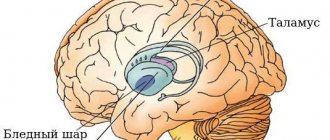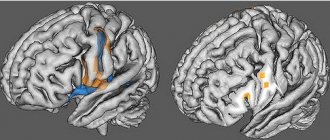What is dyslalia in children
The defect is characterized by a violation of the pronunciation of sounds and their pathological use. At the same time, there is no organic pathology of the nervous system and hearing organs. It is a common pathology that is diagnosed more often in preschool children. Normally, at this age, speech formation ends, the baby composes coherent sentences using words often used in everyday life. It is during this period that speech defects are identified.
Manifestations of dyslalia are varied and subsequently lead to difficulties in writing and reading.
Causes of dyslalia in children
There are mechanical and functional reasons for the development of the disease. Mechanical causes of dyslalia disorders are organic pathologies of the speech organs:
- shortened frenulum of the lips or tongue, which limits movement;
- enlargement of the tongue or, conversely, its decrease, which occurs with physical or mental underdevelopment;
- thickened lips with limited mobility;
- abnormalities of lip development.
This group also includes developmental anomalies of the dentofacial apparatus. They can be congenital - primary dyslalia, or acquired - secondary, appearing as a result of injuries and diseases. Anomalies are represented by malocclusion, dentition, too low or high upper palate.
The group of functional causes includes those factors that are not associated with an anatomical defect, but negatively affect the development of speech skills:
- biological - general weakness, when children often get sick, and the illness is severe; encephalopathy with a violation of the psycho-emotional sphere, which leads to a delay in psycho-speech development, a lag in the formation of phonemic hearing, speech patterns, and the inability to switch when moving from one sound to another;
- social - the presence in the immediate environment of a person with a speech disorder of any degree and severity: rapid, dialectal, tongue-tied; as well as the child’s lisping, bilingualism, lack of parental interest in his development (parents are not involved in him).
Causes of the disease
The main causes of the occurrence and development of the disease are organic and functional.
Organic dyslalia develops due to the presence of features in the structure of the speech apparatus, which include, for example, a short frenulum of the tongue, limited mobility of the tongue and lips for physiological reasons, and features in the structure of the upper palate. Its treatment requires a correct diagnosis and subsequent elimination of the causes of distorted pronunciation of sounds or staging the pronunciation taking into account the child’s physiological characteristics. The roots of functional dyslalia are predominantly social. These include the pedagogical neglect of the child, when his close relatives and environment do not correct the mistakes he makes in pronunciation, as well as a multilingual environment, which is characterized by different systems of pronunciation of sounds. In addition, children always imitate adults, and if parents make mistakes in pronunciation, then their children tend to speak the same. In addition, the cause of functional dyslalia can be a general weakening of the child’s body caused by a long-term illness. Dyslalia that arises for functional reasons almost always goes away on its own, without the participation of a speech therapist.
Types of dyslalia in a child
As can be seen from the reasons, there are 2 forms of pathology. Functional dyslalia of speech is divided into 3 types:
- motor, which occurs as a result of neurodynamic changes in the central parts of the speech motor analyzer. It is characterized by inaccurate pronunciation of sounds, their distortion, while the baby selects the sound correctly. This phenomenon is called a phonetic defect;
- the sensory form is accompanied by the same disturbances, but in the speech-hearing analyzer. Difficulties arise in the auditory discrimination of phonemes that are similar in pronunciation: voiced and voiceless, hard and soft consonants, hissing and whistling. The kids replace one with the other, mix them up, and the replacements are always repeated. This form is defined as a phonemic defect;
- A feature of sensorimotor dyslalia is the presence of both substitutions and distortions of sounds.
Based on the number of pathological sounds, simple dyslalia is distinguished, when the baby pronounces 1-4 sounds incorrectly, and complex dyslalia - more than 4 sounds.
Depending on the sounds and nature of the defect
Depending on what signs of sounds are affected (acoustic, articulatory), and what nature of the defect is present, the following types of disorders in dyslalia are distinguished:
- an acoustic-phonemic form, sometimes mistakenly called acoustic dyslalia - the baby does not distinguish between acoustically close phonemes. Pronounces sounds correctly, without defect, but either misses them or replaces them, for example, says “sh” instead of “zh” in the word “beetle”;
- the articulatory-phonemic form is characterized by the use of “wrong” sounds due to impaired phonemic hearing and the inability to sense the position of the speech organs and control their movements;
- articulatory-phonetic form, erroneously - articulatory dyslalia, is caused by distortion of sounds due to pathologically formed articulatory positions, while the baby perceives sounds correctly by ear.
Due to lack of pronunciation of sounds
Speech therapy uses a classification using the Greek alphabet: it takes into account the shortcomings in the pronunciation of sounds of different groups.
| Term | Lack of pronunciation |
| Rotacism | hard, soft "r" |
| Lambdacism | hard, soft "l" |
| Sigmatism | whistling, hissing |
| Yotacism | "th" |
| Gammacism | hard, soft "g" |
| Kappacism | hard, soft "k" |
| Hitism | hard, soft "x" |
| Stun/Voice Deviations | replacing voiced consonants with voiceless ones and vice versa |
| Hardness/softening deviations | replacing soft consonants with hard ones and vice versa |
There are also combined defects.
Acoustic-phonemic dyslalia - definition
Dyslalia is translated from Greek as “speech and disorder.” Acoustic-phonemic dyslalia develops when phonemic hearing is impaired (immature), namely:
- inability to recognize and recognize sounds;
- inability to differentiate sounds of adjacent phonetic groups.
This defect is not associated with hearing aid pathologies. Acoustic-phonemic dyslalia is based on selective impairments in the ability to distinguish phonemes in oral speech and reproduce sounds correctly.
Patients with phonemic disorder have difficulty distinguishing sounds and recognizing them correctly. The composition of phonemes with such a defect is not completely formed. Because the baby misrecognizes the sound, he misunderstands the entire word. Example: a child does not understand the difference between the words “hole” and “bark”, “beetle” and “bough”.
Symptoms of dyslalia in children
Various signs of dyslalia are observed. One of the options is omissions, when various sounds drop out of speech during a conversation. The next symptom is the replacement of sounds with dyslalia. Patients replace one sound with another. This happens due to the difficulty of determining the pronunciation features of sounds.
There may also be confusion, when the child either confuses sounds or pronounces them correctly. The cause of the disorder is poor assimilation of the phoneme system.
Distortion is characterized by abnormal pronunciation in dyslalia, when children use sounds that are not in the language. They may distort sounds or pronounce them using the wrong organs: interdental “s” instead of the correct fricative.
In the functional form of the pathology, the pronunciation of one or several sounds is impaired, while in the mechanical form, the pronunciation of many sounds that are similar in pronunciation is impaired. For example, with an anterior open bite, when there is no contact between the teeth in the anterior regions, the tip of the tongue cannot maintain a position behind the teeth.
The lexical and grammatical component of speech is formed according to age. The vocabulary is sufficient, the syllable structure is normal, the inflection of words is correct. Thinking with dyslalia is intact. The baby shows a high level of coherent speech in a conversation and understands spoken speech.
In addition to pathological, there is also age-related dyslalia, or physiological. Its cause is imperfect speech skills associated with age. Over time, these disorders go away on their own and do not require specialized help.
Causes of the disorder and mechanism of development
Provoke the appearance of a defect:
- Physiologically incorrect formation of the maxillofacial system, mouth and nasopharynx. Anatomical abnormalities lead to incorrect articulation of entire groups of sounds. Children with an anterior bite have problems pronouncing sibilant consonants because it is difficult to hold the tongue behind the teeth.
- Despite normal physiological hearing indicators, children with acoustic-phonemic dyslalia have not developed a sensory understanding of oral speech. There is no recognition function, comparison of common and different features of phonemes, as a result of which the child perceives words incorrectly.
The main reason for such a speech disorder is the immaturity of phonemic hearing.
The child does not distinguish between sounds, so he replaces one with the other when pronouncing. Usually, the sounds of one acoustic group are replaced: sonorant, whistling, hissing, voiced or voiceless.
Diagnosis of dyslalia in children
Examination for speech disorders consists of neurological and speech therapy diagnostics:
- Speech therapy involves finding out information about the mother’s pregnancy, previous illnesses and the characteristics of childbirth. The specialist collects data on early development: physical, neuropsychic, diseases and injuries;
- The next stage is an assessment of the structure of the organs of articulation, their mobility, and participation in speech production. The specialist also determines the perception of sounds. Then the speech therapist assesses the state of sound pronunciation. Pays attention to which sounds are pronounced correctly and which are not. Finds out the nature of the violations: replacement, omissions, distortion, confusion, as well as the conditions for the occurrence of the defect and its place in the word.
Based on these data, the specialist determines the type of disorder and selects a correction scheme to overcome dyslalia. If necessary, the patient is examined by an otolaryngologist to exclude hearing pathology, a dentist to exclude diseases of the oral cavity, anomalies in the structure of teeth and jaws, and a neurologist to exclude neurological pathology. Hardware research methods may also be needed: radiography, MRI or CT, audiometry.
Methods for correcting dyslalia in a child
Correction of dyslalia consists of three stages: initial, formation of primary pronunciation skills and communication skills.
Preparatory stage . In organic pathology, it consists of eliminating the cause, that is, the defect. Plastic surgery (excision) of the short frenulum and orthodontic correction (bite correction) are indicated. The motor form of functional dyslalia is corrected by the development of the speech organs with the help of exercises, massage, and in the sensory form - by the development of phonemic processes.
An important component of therapy is developing skills for the correct use of breathing in conversation, exercises for fine motor skills, and strengthening the pronunciation of basic sounds.
Formation of pronunciation skills. It consists of producing individual sounds and automating sounds in speech. Imitation and sessions with a speech therapy probe are used.
Formation of correct speech skills in communication . The results of the previous stages are consolidated and the skills of correct use of sounds in communication, expressive, monologue and dialogue speech are formed.
A correction program for mild dyslalia can last up to 3 months, for complex dyslalia - up to six months. It is important that classes are regular and not interrupted. The frequency of classes and their duration are selected by the speech therapist, taking into account the severity of the pathology and the age of the patient. If possible, parents should work with their preschooler at home.
For age-related dyslalia, no correction is required. But you need to monitor the development of speech and, if necessary, begin treatment.
Next, we will look at effective exercises that parents can do at home. Check with your speech therapist to see if they are appropriate for your situation.
Exercises to eliminate mechanical dyslalia
A set of exercises is compiled by a speech therapist, taking into account the severity of symptoms and the main cause of the speech defect. Each patient has an individual set of exercises. Finger exercises and breathing exercises are effective. For young children, exercises are carried out in a playful way to ensure interest. Such exercises will give results if the organic cause is eliminated.
Articulation exercises for lips
The exercises can be done at home on your own. But the first session must be carried out with a speech therapist. He will demonstrate effective movements and check the correct positioning of the lips when performing exercises. This approach will allow you to develop your lip muscles and develop the skill of using them in conversation.
For example, you need to stick out your tongue, relax it, spreading it over your lower lip. Then we roll the tongue into a tube and pull it forward as far as possible. After this, we also stretch our lips and roll them into a tube. Let your baby do these exercises in front of a mirror.
Diagnostic rules
To identify a speech defect, the following is studied:
- facial expressions;
- work of articulatory muscles: tongue, palate, lips, lower jaw.
To do this, the child is asked to open his mouth as wide as possible several times. Then smile, form your lips into a tube (these tasks alternate), stick your tongue forward, lowering it onto your lower lip (“shovel”), then make the tongue as narrow as possible (“needle”). Alternate tasks for the language. Say “a” abruptly and clearly, then yawn, opening your mouth as much as possible. Repeat.
Prognosis and prevention
With timely initiation of treatment, correction of dyslalia is effective: the baby begins to speak correctly, and pronunciation defects disappear. The result is influenced by the complexity of the case, the individual characteristics of the child, the state of the nervous system and concomitant diseases. The sooner treatment is started, the faster the result will be. Advanced cases are more difficult to correct, but with diligence you can get rid of speech disorders.
Prevention of dyslalia consists of strengthening the child’s health, preventing somatic diseases and injuries. Do not distort your speech in front of your baby: speak correctly, pronouncing words slowly and clearly. Babysitting and imitating children's speech is not only inappropriate, but also dangerous in terms of the fact that children then begin to imitate you. It is important that all family members adhere to these principles.
If there are any anatomical deviations, they must be corrected in a timely manner. This is only possible with early detection, which means you need to undergo medical examinations in a timely manner. If you notice anything unusual: problems with sucking, baby refusing to breastfeed, crying, consult your doctor. After a year, pay attention to the development of speech, the nature of the pronunciation of sounds and syllables.
Tips for parents
Engage in your baby's development from an early age. Talk to him, play educational games, pay attention to finger exercises. Name objects when you are at home, when you are walking outside. Talk about your activities, even when doing housework. Read fairy tales, do massage and gymnastics, draw, sculpt.
With older children you can learn tongue twisters and poems. This will contribute to the proper development of the nervous system, articulatory muscles, and also improve memory.
But don't overdo it. Your excessive demands and constant control of speech can provoke other speech disorders, such as stuttering.
I wish you success! Let the baby develop according to his age.
How to treat dyslalia and get rid of tongue-tiedness?
At the first consultation, the doctor will tell you how to treat dyslalia in Saratov in preschoolers and schoolchildren, how to cure dyslalia in Russia in children of preschool and school age, how to get rid of tongue-tiedness , what is articulatory phonemic, articulatory phonemic and phonetic, motor and sensory, mechanical, monomorphic, phonemic, simple, complex dyslalia in preschool children. How is prevention, correction of dyslalia , speech therapy examination of children with dyslalia carried out? Does speech therapy psycho-correctional pedagogical communication work help? How does sound pronunciation suffer with dyslalia? Why is polymorphic dyslalia dangerous, what is cheiloplasty, uranoplasty? What is the etiology and causes of dyslalia, differential diagnosis, exercises, gymnastics, literature, conclusion? What is rhinolalia, dysarthria, FNR, FFN, speech card? What is the prevention of dyslalia ? Sarklinik knows how to treat dyslalia in children in Russia.
Sarclinic provides treatment for aphonia, dysphonia, bradylalia, treatment of stuttering, tachylalia, open and closed rhinolalia, dyslalia, treatment of alalia, dysarthria, treatment of aphasia, nasalization, treatment of speech delay, dysgraphia, treatment of general speech underdevelopment, hyperkinesis, synkenesia, treatment of speech development disorders, SPD, delays in speech and psycho-speech development, dyslexia in children and adolescents in Saratov.
Sign up for a consultation. There are contraindications. Specialist consultation is required.
Text: ® Sarclinic.com \ Ssrlinic.ru Photo: (©) (©) Gekaskr | Dreamstime.com \ Dreamstock.ru The children depicted in the photo are models, do not suffer from the diseases described and/or all coincidences are excluded.
Related posts:
Depression in adolescents, children, treatment of depression in Saratov
Very active child? Syndrome of movement disorders, disorders, motor disinhibition
Agraphia: causes, symptoms, treatment of agraphia
Cerebrasthenic syndrome: treatment, symptoms in children, adults
Alalia for children, alalia treatment, motor, sensory, sensorimotor










